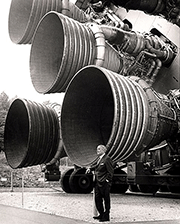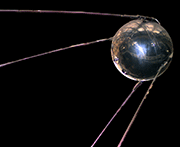E-Archive
Off the Beaten Track
in Vol. 20 - January Issue - Year 2019
Operation Paperclip

Wernher von Braun in front of his Saturn V rocket

Sputnik 1, first Earth satellite (replica)
The enemy army was a hundred and fifty kilometers away and advancing very rapidly over the flat countryside. The young engineer realized that he had to devise an escape plan and try to save himself and as many of his collaborators as he could. With unseeing eyes, he stared out the window as he pondered his options. A few moments later, he jumped out of his chair and quickly assembled his staff in the large meeting room next to his office.
****
Space travel had always fascinated Wernher von Braun. Born in Wirsitz, Germany in 1912, he was inspired by the works of rocket pioneer Hermann Oberth, whose book entitled By Rocket into Planetary Space Wernher had read in his early teens. He joined the Spaceflight Society at university and got his engineering diploma in 1932. For his post-graduate degree, Wernher studied physics, astronomy and chemistry and achieved his doctorate in physics (aerospace engineering) at the age of twenty-two.
Two years earlier, von Braun had been invited to join a small team of engineers working on rockets for military purposes. Although he was interested only in space travel, Wernher reluctantly found himself more and more involved in Germany’s military buildup. In 1936, von Braun’s group successfully tested rocket engines applied on standard aircraft. The first tests were run on Heinkel propeller-driven airplanes, with the piston-driven engines shut off. When war broke out, von Braun was appointed technical director of the ballistic missile program at the secret Peenemünde army rocket base. Here the team developed the A-4 rocket, the first vehicle to reach outer space during test flights in 1942 and 1943. The German military imposed the mass production of this rocket as the infamous V2, used to bomb southern England and parts of Europe in 1944 and 1945. There was no defense against this vehicle, which carried a 1,130 kg warhead at a supersonic speed of 4,000 km/h.
No other country had anything close to this technology. When it became clear that Germany was losing the war, the capture of German rocket engineers, their blueprints and as many specimens of the A-4/V2 as possible became a top priority for the Western Allies and for the Soviet Union.
The United States created Operation Paperclip, a secret program that led to the identification and subsequent recruitment of more than 1,600 German engineers, scientists and technicians. These people were taken to the U.S. and offered government employment. The Americans also managed to capture a considerable number of rockets.
Wernher von Braun and his V2 team chose to surrender to the Americans rather than be captured by the Soviet Army, which was rapidly approaching the Peenemünde base from the east. It appears that British intelligence officers and scientists were the first to interview von Braun, knowing that U.S. officials would not share any information. The British interrogation team included L.S. Snell, the leading British rocket engineer who would later become chief designer at the aerospace division of Rolls-Royce Limited and inventor of the Concorde's engines. The British never divulged whatever information they got from von Braun, not even to the Americans or to their other allies. Wernher von Braun went on to become the chief architect of the American rocket program and the first director of NASA. He designed ever bigger and more powerful rockets. His mammoth Saturn V rocket powered the first manned mission to the Moon in 1969.
The Soviets had their own secret program, code named Operation Osoaviakhim, the important difference being that they forcibly removed 2,200 German specialists with their families at gunpoint, for a total of over 6,000 people, with their furniture. The operation took place on 22nd October 1946 and required the use of 92 trains. The Soviet team was led by Sergei Korolev, who would later become the USSR’s chief aerospace engineer. He designed the rockets and the spacecraft for the first orbital satellite (October 1957) and the first manned space flight (April 1961). His R-7 family of rockets, which launched the first Sputnik satellite, is still used today to carry Russian and American crews to and from the International Space Station.
The V2 would become the basic rocket design for both the Americans and the Soviets.
The stage was set for the Space Race. In the summer of 1955, the United States and the Soviet Union almost simultaneously announced their intention to launch artificial satellites into space. Their plans were not based on purely scientific considerations, but were part of a climate of increasing competition and hostility that became known as the Cold War.
By Giovanni Gregorat, Contributing Editor MFN



























